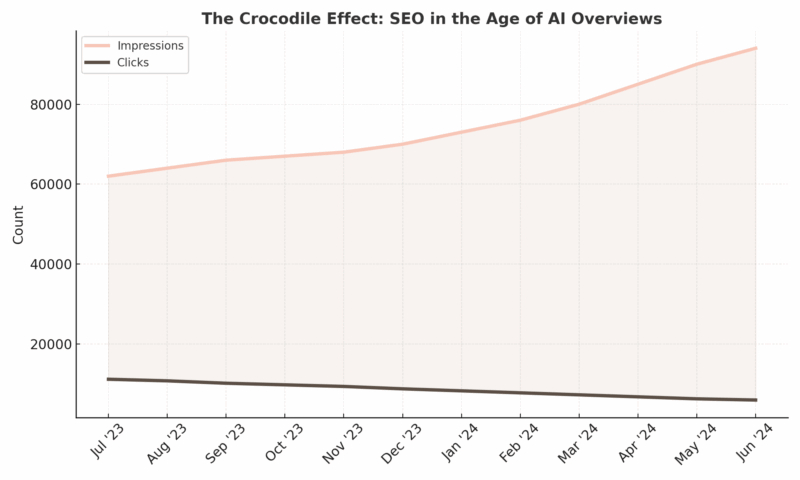Over the past year, many marketing teams have opened Google Search Console, seen a drop in clicks, and asked:
“Is our content failing?”
That’s a reasonable question—until you look a little closer. Because what’s actually happening isn’t failure. It’s a structural change in how people search.
Meet the “Crocodile Effect”
Since mid-2023, a consistent pattern has emerged in Search Console data for many sites:
- Impressions are going up
- Clicks are going down
This diverging trend has been nicknamed the Crocodile Effect. It’s being driven by changes in how Google surfaces information—specifically, the rollout of AI Overviews (formerly “Search Generative Experience”).

Why It’s Happening
Google’s new AI-generated summaries often answer user queries directly on the results page. These responses pull from multiple sources, cite content, and increasingly eliminate the need to click through to a website.
As a result:
- You might still rank highly or be cited in an AI summary.
- But the user gets their answer immediately, without clicking.
This is classic zero-click behaviour, accelerated by generative AI.
What This Doesn’t Mean
It doesn’t mean your content isn’t valuable.
It doesn’t mean you’re being outranked.
It doesn’t mean your SEO strategy is broken.
In fact, if your impressions are rising, it likely means your content is still being seen—it’s just being surfaced in a different format.
This is why first-party data matters more than ever. Many third-party SEO tools can underreport traffic by a factor of 5–10x compared to Search Console. Always trust the primary source.
What to Do About It
1. Shift the success metric
Clicks alone are no longer the best proxy for value. Visibility and influence on the buying journey—even without a click—are now key.
2. Optimize for “fan-out”
One large topic may now need to be split into multiple, specific pieces. AI Overviews tend to pull from narrowly focused content that aligns tightly to individual user intents.
Example: Instead of “Microsoft 365 Security Best Practices,” consider also writing posts on:
- “Conditional Access Policy Setup”
- “How to Audit Weak Passwords in Microsoft Entra”
- “Microsoft Defender for Office 365 Configuration Tips”
3. Track LLM visibility
It’s not just about Google anymore. Users are also searching with tools like ChatGPT, Perplexity, and Copilot. Some marketers are starting to track presence across these surfaces, too.
What Might Come Next
While traditional web traffic may drop, purchase intent might actually rise. Users who’ve researched via AI and LLMs could arrive on your site more informed and ready to convert.
In one case I came across recently, traffic originating from ChatGPT converted at 7x the rate of regular organic. That makes sense—if the AI has already explained your value, you’re meeting the visitor mid-funnel, not top.
Final Thought
SEO isn’t dying, but it is evolving.
It’s no longer just:
“How do I rank?”
But:
“Where am I surfaced, and how?”
Understanding this shift—and adjusting accordingly—will separate the frustrated from the forward-thinking in the next wave of digital strategy.
Originally published at bjrees.com.


Leave a Reply